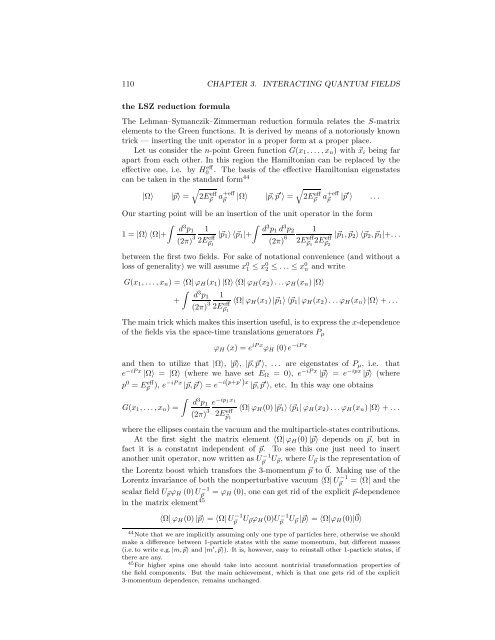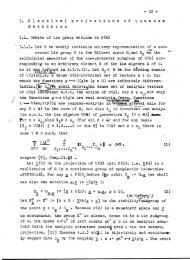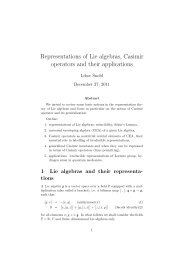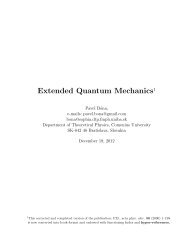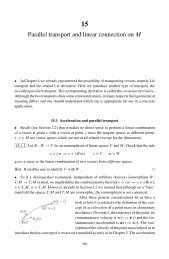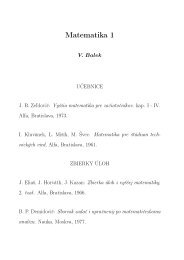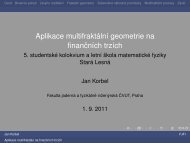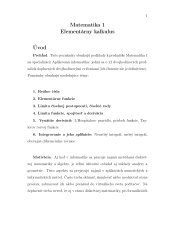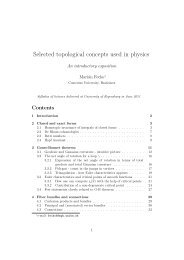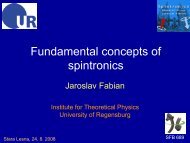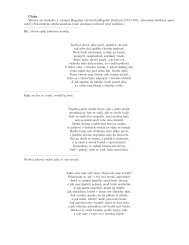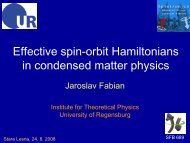Quantum Field Theory I
Quantum Field Theory I
Quantum Field Theory I
You also want an ePaper? Increase the reach of your titles
YUMPU automatically turns print PDFs into web optimized ePapers that Google loves.
110 CHAPTER 3. INTERACTING QUANTUM FIELDS<br />
the LSZ reduction formula<br />
The Lehman–Symanczik–Zimmerman reduction formula relates the S-matrix<br />
elements to the Green functions. It is derived by means of a notoriously known<br />
trick — inserting the unit operator in a proper form at a proper place.<br />
Let us consider the n-point Green function G(x 1 ,...,x n ) with ⃗x i being far<br />
apart from each other. In this region the Hamiltonian can be replaced by the<br />
effective one, i.e. by H0 eff . The basis of the effective Hamiltonian eigenstates<br />
can be taken in the standard form 44<br />
|Ω〉 |⃗p〉 =<br />
√<br />
2E eff<br />
⃗p a+eff ⃗p<br />
|Ω〉 |⃗p,⃗p ′ 〉 =<br />
√<br />
2E eff<br />
⃗p a+eff ⃗p<br />
|⃗p ′ 〉 ...<br />
Our starting point will be an insertion of the unit operator in the form<br />
∫ d 3 ∫<br />
p 1 1 d 3 p 1 d 3 p 2 1<br />
1 = |Ω〉〈Ω|+<br />
(2π) 3 2E⃗p eff |⃗p 1 〉〈⃗p 1 |+<br />
1<br />
(2π) 6 2E⃗p eff<br />
1<br />
2E⃗p eff |⃗p 1 ,⃗p 2 〉〈⃗p 2 ,⃗p 1 |+...<br />
2<br />
between the first two fields. For sake of notational convenience (and without a<br />
loss of generality) we will assume x 0 1 ≤ x0 2 ≤ ... ≤ x0 n and write<br />
G(x 1 ,...,x n ) = 〈Ω|ϕ H (x 1 )|Ω〉〈Ω|ϕ H (x 2 )...ϕ H (x n )|Ω〉<br />
∫ d 3 p 1 1<br />
+<br />
(2π) 3 2E⃗p eff 〈Ω|ϕ H (x 1 )|⃗p 1 〉〈⃗p 1 |ϕ H (x 2 )...ϕ H (x n )|Ω〉+...<br />
1<br />
The main trick which makes this insertion useful, is to express the x-dependence<br />
of the fields via the space-time translations generators P µ<br />
ϕ H (x) = e iPx ϕ H (0)e −iPx<br />
and then to utilize that |Ω〉, |⃗p〉, |⃗p,⃗p ′ 〉, ... are eigenstates of P µ , i.e. that<br />
e −iPx |Ω〉 = |Ω〉 (where we have set E Ω = 0), e −iPx |⃗p〉 = e −ipx |⃗p〉 (where<br />
p 0 = E⃗p eff),<br />
e−iPx |⃗p,⃗p ′ 〉 = e −i(p+p′ )x |⃗p,⃗p ′ 〉, etc. In this way one obtains<br />
∫ d 3 p 1 e −ip1x1<br />
G(x 1 ,...,x n ) =<br />
(2π) 3 2E⃗p eff 〈Ω|ϕ H (0)|⃗p 1 〉〈⃗p 1 |ϕ H (x 2 )...ϕ H (x n )|Ω〉+...<br />
1<br />
wheretheellipsescontainthevacuumandthemultiparticle-statescontributions.<br />
At the first sight the matrix element 〈Ω|ϕ H (0)|⃗p〉 depends on ⃗p, but in<br />
fact it is a constatnt independent of ⃗p. To see this one just need to insert<br />
another unit operator, now written as U −1<br />
⃗p U ⃗p, where U ⃗p is the representation of<br />
the Lorentz boost which transfors the 3-momentum ⃗p to ⃗0. Making use of the<br />
Lorentz invariance of both the nonperturbative vacuum 〈Ω|U −1<br />
⃗p<br />
= 〈Ω| and the<br />
scalar field U ⃗p ϕ H (0)U −1<br />
⃗p<br />
= ϕ H (0), one can get rid of the explicit ⃗p-dependence<br />
in the matrix element 45<br />
〈Ω|ϕ H (0)|⃗p〉 = 〈Ω|U −1<br />
⃗p U ⃗pϕ H (0)U −1<br />
⃗p U ⃗p|⃗p〉 = 〈Ω|ϕ H (0)|⃗0〉<br />
44 Note that we are implicitly assuming only one type of particles here, otherwise we should<br />
make a difference between 1-particle states with the same momentum, but different masses<br />
(i.e.to write e.g.|m,⃗p〉 and |m ′ ,⃗p〉). It is, however, easy to reinstall other 1-particle states, if<br />
there are any.<br />
45 For higher spins one should take into account nontrivial transformation properties of<br />
the field components. But the main achievement, which is that one gets rid of the explicit<br />
3-momentum dependence, remains unchanged.


